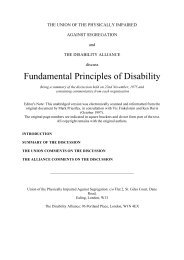Global-Report-Living-Colour-dr2-2
Global-Report-Living-Colour-dr2-2
Global-Report-Living-Colour-dr2-2
Create successful ePaper yourself
Turn your PDF publications into a flip-book with our unique Google optimized e-Paper software.
62<br />
Inclusive Communities = Stronger Communities<br />
GLOBAL REPORT ON ARTICLE 19: THE RIGHT TO LIVE AND BE INCLUDED IN THE COMMUNITY<br />
The Swensons’ story<br />
Charlie Swenson does not communicate in traditional<br />
ways and has significant support needs. His family<br />
and support team, based on their deep knowledge of<br />
who he is, what he likes and does not like, work<br />
together to articulate Charlie’s decisions. His mother,<br />
Sue knows the dangers of guardianship—of having<br />
one voice speak for Charlie—and believes in the<br />
need for a collective approach to ensure that<br />
although Charlie doesn’t communicate his decisions<br />
the way others do, his decisions are still his. This<br />
was evident in the way the Charlie’s family and<br />
support team helped him find his own place in the<br />
community.<br />
Charlie informed the family he was ready to move<br />
out on his own. Charlie, who uses a wheelchair to<br />
move around, had taken to wheeling himself to the<br />
front door and knocking on the back of it. People<br />
who do not know Charlie might not have understood<br />
what he was communicating—or that he was<br />
communicating at all. But the Swenson’s knew, and<br />
so began a long journey to find appropriate housing<br />
in the community for Charlie. A possible roommate<br />
was quickly found. On paper it was a great match.<br />
The families knew each other, shared similar values<br />
and a commitment to inclusion, the young adults<br />
knew each other and got along well. But there was a<br />
hitch. Charlie liked Opera and he liked it loud. His<br />
potential housemate didn’t and preferred a quiet<br />
living environment. Under guardianship, or if less<br />
care and consideration was given to Charlie’s will, it<br />
would have been easy to have the two become<br />
housemates. However, through supported decisionmaking<br />
and a dedicated family, the Swenson’s knew<br />
this would not be the decision Charlie would make<br />
for himself. So they went on a new search until they<br />
finally found a house that Charlie can call home.<br />
making and the lack of legal mechanisms to<br />
enable supported decision-making. The<br />
history of families making these decisions is<br />
an uneasy one. We know the vast majority of<br />
families are driven by love and their desire to<br />
“protect” their sons and daughters. Yet,<br />
under the name of protection, individuals are<br />
being denied their rights. Families are often<br />
led to believe that “protection” is best<br />
secured through substitute decision-making<br />
arrangements. In many countries there is<br />
little experience or understanding that<br />
people with intellectual disabilities can make<br />
their own decisions. Particularly, for people<br />
with significant challenges in communicating<br />
in traditionally understood ways, it is difficult<br />
for others to see how a person can make<br />
their own decisions. As we witness the rise in<br />
self-advocacy movements around the world<br />
we are seeing people with intellectual<br />
disabilities challenge stereotypes and<br />
traditional assumptions. They are pushing<br />
for change and leading the way forward.<br />
They are challenging “protectionism” and tell<br />
us they want to make mistakes and learn<br />
from them like people without disabilities.<br />
They are demonstrating that with support<br />
they can make their own decisions.<br />
Despite the fact that Article 12 obliges<br />
governments to develop supported decision<br />
making models, formal recognition of<br />
supported decision making exists in only a<br />
very few countries and is not always well<br />
understood by families, professionals or<br />
communities. Supported decision-making is<br />
an approach to decision making that can be<br />
used when an individual needs help to make<br />
decisions in their lives. Supported decision<br />
making recognizes that everyone makes



